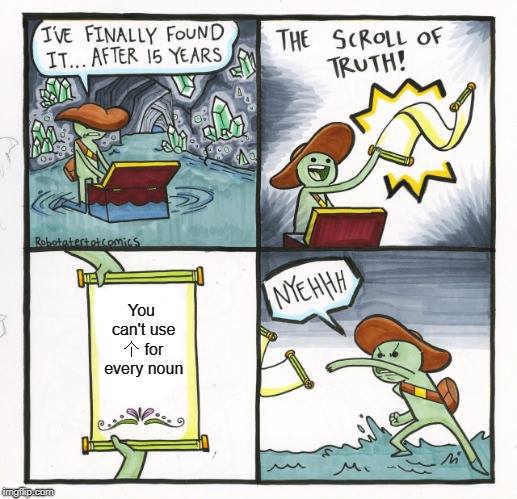
To a native English speaker learning Chinese as a second language, measure words can be a difficult concept to grasp. Not only is there a lot of memorization involved, but English speakers aren’t used to thinking about measure words.
In Chinese, a measure word like 个 (gè) must be used to link a noun to a number or demonstrative pronoun. Because of how frequently they are used, measure words are an essential part of daily Chinese communication.
You may not realize it, but you already use measure words in English all the time--a cup of coffee, two slices of pizza, a pair of shoes, a flock of birds. However, the vast majority of English nouns can be numbered without any collective noun (e.g. three books, eight pens). But since Chinese measure words are mandatory, the real stumbling block for Chinese language learners is knowing which of the hundreds of measure words to use with a particular noun.
You’re likely familiar with 个 as well as 杯 (bēi, cup) and 张 (zhāng, measure word for flat objects) already. In this blog post, we’ll review how to use measure words and go over 10 more commonly used measure words you should know.
Why Should You Care About Measure Words?
If someone approached you in a store and asked for “three pants” or “two breads,” you would probably look at them a little strangely. If you omit the measure word completely, that’s how you sound to a native Chinese speaker. You can get away with using a generic measure word like 个or 些 (xiē) in front of most nouns, but your speech will sound inelegant at best and infantile at worst. Consider the difference between “A bunch of cows grazed in the field next to a bunch of geese” and “A herd of cows grazed in the field next to a flock of geese.”
Given the tremendous amount of work, time, and practice it takes to become fluent in Chinese, do you really want to come off sounding uneducated because you overuse the generic 个 or forget to use a measure word at all? Of course not!
Studying measure words can also give you a glimpse into Chinese culture. By considering what nouns share a common measure word, you can get a better understanding of how ancient Chinese speakers thought. For instance, the nouns ‘worm’, ‘snake’, and ‘river’ all take the measure word 条 (tiáo), which tells us that an elongated, undulating shape is the common conceptual link between these three wildly different things. Likewise, the fact that the noun ‘horse’ gets its own unique measure word (匹 pǐ) suggests how important horses were to the ancient Chinese. Some nouns take on more than one measure word in order to emphasize different aspects of the noun. For example, when counting family members, instead of 一个人 (yí gè rén; a person), you can say 一口人 (yì kǒu rén; lit. ‘one mouth of a person’), indicating a mouth (person) to be fed.
How to Use Measure Words: a Refresher
In Chinese, a number is not followed immediately by a noun. Instead, a measure word is inserted between the number and the noun, or between a demonstrative pronoun (like 这 [zhè] or 那 [nà]) and a noun. Below we have provided some basic structures and examples:
number + measure word + noun
一个人 (yí gè rén, a person)
我要两杯咖啡。(Wǒ yào liǎng bēi kāfēi. I would like two cups of coffee.)
A reminder: you should use 两 (liǎng) instead of 二 (èr, two), because 二 cannot be followed by a measure word.
这/那 + measure word + noun
这本书 (zhè běn shū, this book)
你喜欢这件衬衫还是那件衬衫? (Nǐ xǐhuān zhè jiàn chènshān háishì nà jiàn chènshān? Do you like this shirt or that shirt?)
几/多少 + measure word + noun?
To ask a question about the quantity of a noun, use 几 (jǐ, how many) or 多少 (duōshǎo, how many) to replace the number. 几 is usually used when the number is less than 10 and 多少 is used for quantities of 10 or more.
你有几个姐姐? (Nǐ yǒu jǐ gè jiějie? How many older sisters do you have?)
你去过多少个国家?(Nǐ qùguò duōshǎo gè guójiā? How many countries have you been to?)
There are over one hundred measure words in Chinese--enough to fill an entire dictionary--but only two or three dozen are used in everyday conversation. 个 is the single most common measure word. If you draw a blank on the proper measure word to use, 个 is usually a safe default. However, many nouns are associated with specific measure words, and when you replace certain measure words with 个, it can sound jarring (take 一个书, for example).
Therefore, it is well worth your time to learn some of the most frequently used measure words and the types of nouns they are associated with. To get you started, we’ve listed 10 common measure words with examples below.
1. 把 (bǎ)
把 is used for objects with a handle or things that can be held by hand. 一把 can also mean “a handful of.” Notably, chairs take the measure word 把, but not sofas or stools, which take the measure word 张 (zhāng) because they are flat objects.
- 一把叉子 (yì bǎ chāzi, a fork)
- 一把香蕉 (yì bǎ xiāngjiāo, a bunch of bananas)
- 一把椅子 (yì bǎ yǐzi, a chair)
- 一把沙子 (yì bǎ shāzi, a handful of sand)

2. 袋 (dài)
袋 is used for a bag, sack, or packet of something.
- 一袋土豆 (yí dài tǔdòu, a sack of potatoes)
- 一袋糖 (yí dài táng, a packet of sugar)
3. 份 (fèn)
份 refers to a portion or share of something. The noun that follows can be concrete, like food, or abstract, like a job. 份 is also used to mean a copy of a print material.
- 一份报告 (yí fèn bàogào, a copy of a report)
- 一份报纸 (yí fèn bàozhǐ, a newspaper)
- 一份复印件 (yí fèn fùyìnjiàn, a photocopy)
- 一份食品 (yí fèn shípǐn, a portion of food)
- 找到了一份工作 (zhǎo dào le yí fèn gōngzuò, got a job)
- 请再给我一份。 (Qǐng zài gěi wǒ yí fèn. Give me another helping, please.)
4. 块 (kuài)
块 refers to a piece, lump, or chunk of something. In colloquial speech, it can also be used to quantify money (五块钱 [wǔ kuài qián] versus the more formal 五元 [wǔ yuán])
- 一块蛋糕 (yí kuài dàngāo, a piece of cake)
- 一块披萨 (yí kuài pīsà, a piece of pizza)
- 一块石头 (yí kuài shítou, a stone)
- 一块玻璃 (yí kuài bōlí, a piece of glass)
5. 支 (zhī)
支 is used for elongated stick-shaped objects and contingents of people.
- 一支铅笔 (yì zhī qiānbǐ, a pencil)
- 一支花 (yì zhī làzhú, a candle)
- 一支乐队 (yì zhī yuèduì, a band)
- 一支军队 (yì zhī jūnduì, an army)
When talking about stick-shaped objects, 支 is often synonymous and interchangeable with 枝 (zhī), except when talking about flowering plants, in which case 枝 must be used.
6. 群 (qún)
群 is used for a throng or group of people or animals. It cannot be used for non-living objects.
- 一群人 (yì qún rén, a crowd of people)
- 一群记者 (yì qún jìzhě, a group of journalists)
- 一群牛 (yì qún niú, a herd of cattle)
- 一群蜜蜂 (yì qún mìfēng, a swarm of bees)

7. 套 (tào)
套 is used for a set of something.
- 一套工具 (yí tào gōngjù, a set of tools)
- 一套家具 (yí tào jiājù, a set of furniture)
- 一套西装 (yí tào Xīzhuāng, a Western-style suit)
In colloquial speech, the noun after 一套 can be left unspecified to mean something you are tired of hearing, like an old argument or a worn-out trick.
- 别跟我来这一套! (Bié gēn wǒ lái zhè yí tào! Don’t try that [nonsense] with me!)
8. 条 (tiáo)
条 refers to something elongated and narrow. Unlike 支, it usually describes an irregular shape. The noun that follows is usually concrete, but can also be abstract, like a human life.
- 一条大街 (yì tiáo dàjiē, a street)
- 一条裤子 (yì tiáo kùzi, a pair of pants)
- 一条河流 (yì tiáo héliú, a river)
- 一条鱼 (yì tiáo yú, a fish)
- 一条人命 (yì tiáo rénmìng, a human life)
Notice that, unlike in English, pants are not referred to as a pair and do not take the measure word 双 (shuāng, pair). Shorts (短裤 duǎnkù), despite their short length, also take the measure word 条--makes you wonder whether pants would take another measure word if shorts had been in style in ancient China!
9. 位 (wèi)
位 is used before a person to show respect. While 个 and 名 (míng) can also be used to refer to a person, 位 is more formal and respectful.
- 一位女士 (yí wèi nǚshì, a lady)
- 一位顾客 (yí wèi gùkè, a customer or client)
- 一位老人 (yí wèi lǎorén, an elderly person)
- 各位请注意!Gèwèi qǐng zhùyì! Attention please, everyone!
A quick aside: 各位 is an excellent gender-neutral way of addressing a group of people, and much less wordy than 先生们女士们 (xiānshēngmen nǚshìmen, ladies and gentlemen)!
10. 只 (zhī)
只 is used for an animal, one of a pair (particularly human body parts), or something hollow like a boat or box. When 只 is used as an adverb (meaning “only”) it is pronounced with the third tone, but when it is used as a measure word it is pronounced with the first tone.
- 一只狗 (yì zhī gǒu, a dog)
- 一只鞋 (yì zhī xié, a shoe)
- 一只眼睛 (yì zhī yǎnjīng, an eye)
- 一只船 (yì zhī chuán, a boat)
We can’t possibly cover every Chinese measure word in one blog post, but these ten commonly used measure words will go a long way toward making your Chinese sound more natural. Try to get in the habit of memorizing the appropriate measure word for each new noun you learn. Soon enough, you’ll be much better at spotting patterns and guessing the appropriate measure words for unfamiliar nouns.
Another great resource for expanding your knowledge of Chinese measure words is the Cheng & Tsui Measure Word Dictionary ebook, which brings together 150 of the most frequently used Chinese measure words and a set of the most common nouns, including those featured in the widely used textbook series Integrated Chinese. You can look up nouns in Chinese or English and find all of the measure words associated with a specific noun, or you can look up a measure word and find the group of nouns that take that particular measure word.
Happy counting!


Comments